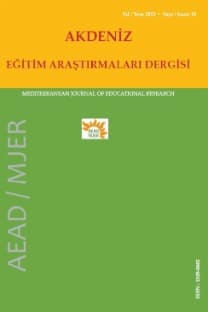Analysis of Studies Made for Mentally Disabled Students in the Mathematics Education: Turkey Example
Zihinsel Engelli Öğrencilerle Matematik Öğretimi Alanında Yapılan Çalışmaların İncelenmesi: Türkiye Örneği
___
Browder, D. M., Spooner, F., Ahlgrim-Delzell, L., Harris, A. A., & Wakemanxya, S. (2008). A metaanalysis on teaching mathematics to students with significant cognitive disabilities. Exceptional Children, 74(4), 407-432.Cantimer, G. G., Şengül, S., & Akçin, N. (2017). Exploring the professional self-efficacy perceptions of the teachers of children in need of special education in terms of various variables. Journal of Human Sciences, 14(1), 694-716.
Cawley, J. F. (2002). Mathematics interventions and students with high-incidence disabilities. Remedial and Special Education, 23(1), 2-6.
Çelenk, S. (2003). Okul başarısının ön koşulu: Okul aile dayanışması. İlköğretim Online, 2(2), 28-34. Ergün, M. (2015). Eğitim felsefesi. Ankara: Pegem Akademi.
Gast, D., Skouge, J., Tawney, J. (1984). Variations of the multiple baseline design: Multiple probe and changing criterion designs. In Tawney, J., Gast, D. (Eds.), Singles subject research in special education (pp. 226–268). Columbus, OH: Merrill.
Gül, G. (2004). Birey toplum eğitim ve öğretmen. Hasan Ali Yücel Eğitim Fakültesi Dergisi, 1(1), 223-236.
Hasselbring, T. S., Goin, L. I., & Bransford, J. D. (1988). Developing math automatically in learning handicapped children: The role of computerized drill and practice. Focus on Exceptional Children, 20(6), 1-8.
Kahyaoğlu, M., & Yangın, S. (2007). İlköğretim öğretmen adaylarının mesleki öz-yeterliklerine ilişkin görüşleri. Kastamonu Eğitim Dergisi, 15(1), 73-84.
Karasar, N. (2016). Bilimsel araştırma yöntemi (30. Basım). İstanbul: Nobel Akademi.
Katsiyannis, A., & Prillaman, D. (1990). Teaching math using regular curricula. Teaching Exceptional Children, 23(1), 26-29.
Knight, V. F., Spooner, F., Browder, D. M., Smith, B. R., & Wood, C. L. (2013). Using systematic instruction and graphic organizers to teach science concepts to students with autism spectrum disorders and intellectual disability. Focus on Autism and Other Developmental Disabilities, 28(2), 115-126.
Kroesbergen, E. H., & Van Luit, J. E. (2003). Mathematics interventions for children with special educational needs: A meta-analysis. Remedial and Special Education, 24(2), 97-114.
Kroesbergen, E. H., Van Luit, J. E., & Naglieri, J. A. (2003). Mathematical learning difficulties and PASS cognitive processes. Journal of Learning Disabilities, 36(6), 574-582.
Luckasson, R., Borthwick-Duffy, S., Buntinx, W. H., Coulter, D. L., Craig, E. M. P., Reeve, A., & Tasse, M. J. (2002). Mental retardation: Definition, classification, and systems of supports. Washington, DC, US: American Association on Mental Retardation.
Milli Eğitim Bakanlığı [MEB]. (2008). Özel Eğitim ve Rehabilitasyon Merkezi Zihinsel Engelli Bireyler Destek Eğitim Programı. Retrieved from https://orgm.meb.gov.tr/meb_iys_dosyalar/2013_09/04010347_zihinselengellibireylerd estekeitimprogram.pdf, 10.08.2018.
Milli Eğitim Bakanlığı [MEB]. (2018). Özel Eğitim Hizmetleri Yönetmeliği. Retrieved from http://orgm.meb.gov.tr/meb_iys_dosyalar/2018_07/09101900_ozel_egitim_hizmetleri_ yonetmeligi_07072018.pdf, 12.09.2018.
Sinoplu, K. (2009). Zihinsel engellilerde matematik öğretimi, (Yayınlanmamış doktora tezi). Selçuk Üniversitesi, Fen Bilimleri Enstitüsü, Konya.
Sönmez, V. (2008). Program geliştirmede öğretmen el kitabı (14. Baskı). Ankara: Anı Yayıncılık.
Sönmez, S. (2003). Türkiye’de öğretmen yetiştirmenin kısa tarihçesi ve yeniden yapılanma. Kazım Karabekir Eğitim Fakültesi Dergisi, , 7, 280-290.
Umay, A. (2001). İlköğretim matematik öğretmenliği programının matematiğe karşı özyeterlik algısına etkisi. Journal of Qafqaz University, 8(1), 1-8.
Tezcan, S. (1985). Eğitim Sosyolojisi (4. Baskı). Ankara: Ankara Üniversitesi Eğitim Fakültesi Yayınları.
Yackel, E., & Cobb, P. (1996). Sociomathematical norms, argumentation, and autonomy in mathematics. Journal for Research in Mathematics Education, 27(4), 458-477.
Yıldırım, A., & Şimşek, H. (2011). Nitel araştırma yöntemleri (8. Baskı). Ankara: Seçkin Yayıncılık.
- ISSN: 1309-0682
- Yayın Aralığı: 4
- Başlangıç: 2008
- Yayıncı: Tayfun Taşbilek
Gülgün BANGİR ALPAN, ÖZDEN DEMİRKAN, Gürcü KOÇ ERDAMAR, NEVRİYE YAZÇAYIR, GÜLÇİN KEZBAN SARAÇOĞLU
Teknostres Kaynakları Ölçeğinin Türkçeye Uyarlama Çalışması
DERYA ORHAN GÖKSÜN, Halil İbrahim M. HASESKİ, ŞENAY OZAN LEYMUN
A Construct Validity Study of a Measure of Pre-Service Teachers' Micro-Teaching Performance
Ortaokul Beşinci Sınıf Matematik Dersi Öğretim Programının Kesirler Ünitesinin Değerlendirilmesi
ÇAĞLAR NACİ HIDIROĞLU, İBRAHİM TUNCEL
A Construct Validity Study of a Measure of Pre-Service Teachers' Micro-Teaching Performance
Sınıf Öğretmenlerinin Süreç Temelli Yazmaya Yönelik Görüşlerinin İncelenmesi
MUAMBER YILMAZ, ÖMER FARUK KADAN
Ortaokul Öğrencilerinde Öz-Yeterlik ile Anksiyete ve Depresyon Arasındaki İlişki
